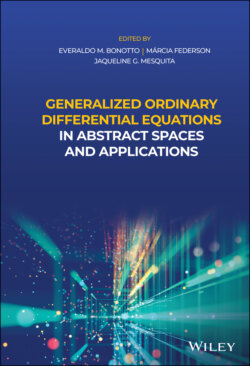Читать книгу Generalized Ordinary Differential Equations in Abstract Spaces and Applications - Группа авторов - Страница 22
1.3.2 Basic Properties
ОглавлениеThe first result we present in this subsection is known as the Saks–Henstock lemma, and it is useful in many situations. For a proof of it, see [210, Lemma 16], for instance. Similar results hold if we replace by and also by .
Lemma 1.45 (Saks–Henstock Lemma): The following assertions hold.
1 Let and . Given , let be a gauge on such that for every ‐fine ,Then, for every ‐fine , we have
2 Let and Given , let be a gauge on such that for every ‐fine ,Then, for every ‐fine , we have
Now, we define some important sets of functions.
Definition 1.46: Let be the set of all functions which are weakly continuous, that is, for every , the function is continuous, and we denote by the set of all weakly regulated functions , that is, for every , the function is r egulated.
Given and , let us define
By the Banach–Steinhaus theorem, the limits and exist and belong to . Then, by the Uniform Boundedness Principle, is a Banach space when equipped with the usual supremum norm. It is also clear that
The next result concerns the existence of Perron–Stieltjes integrals. A proof of its item (i) can be found in [210, Theorem 15]. A proof of item (ii) follows similarly as the proof of item (i). See also [212, Proposition 7].
Theorem 1.47: The following assertions hold.
1 If and , then .
2 If and , then we have .
The following consequence of Theorem 1.47 will be used later in many chapters. The inequalities follow after some calculations. See, for instance, [210, Proposition 10].
Corollary 1.48: The following assertions hold.
1 If and , then the Perron–Stieltjes integral exists, and we haveSimilarly, if and is nondecreasing, then
2 If and , then the Perron–Stieltjes integral exists, and we have
The next result, borrowed from [74, Theorem 1.2], gives us conditions for indefinite Perron–Stieltjes integrals to be regulated functions.
Theorem 1.49: The following assertions hold:
1 if and , then ;
2 if and , then .
Proof. We prove (i). Item (ii) follows similarly. For item (i), it is enough to show that
because, in this case, the equality
follows in an analogous way. By hypothesis, . Hence, given , there is a gauge on such that for every ‐fine division ,
Now, let . Since , there exists , for every . In particular, there exists such that
If and , then by the Saks–Henstock lemma (Lemma 1.45)
Thus,
and the proof is complete.
With Theorem 1.49 at hand, the next corollary follows immediately.
Corollary 1.50: The following statements hold:
1 If and , then .
2 If and , then .
Next, we state a uniform convergence theorem for Perron–Stieltjes vector integrals. A proof of such result can be found in [210, Theorem 11].
Theorem 1.51: Let and , , be such that the Perron–Stieltjes integral exists for every and uniformly in . Then, exists and
We finish this subsection by presenting a Grönwall‐type inequality for Perron–Stieltjes integrals. For a proof of it, we refer to [209, Corollary 1.43].
Theorem 1.52 (Grönwall Inequality): Let be a nondecreasing left‐continuous function, and . Assume that is bounded and satisfies
Then,
Other properties of Perron–Stieltjes integrals can be found in Chapter 2, where they appear within the consequences of the main results presented there.
